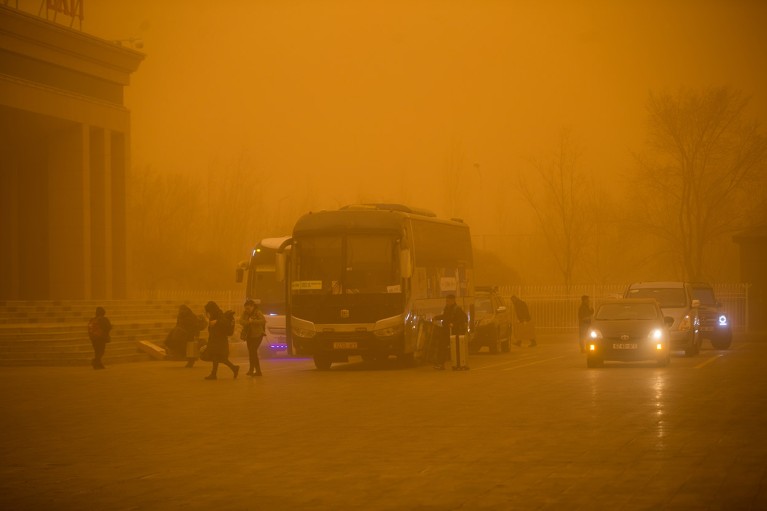[ad_1]

Dust storms turned skies yellow on 27 March 2024 in Erenhot, Inner Mongolia.Credit: VCG via Getty
With the arrival of the Northern Hemisphere spring, many Asian countries are facing an annual problem: dust storms.
Late last month, people living in parts of China’s Inner Mongolia saw their skies turn murky yellow, according to state media. Residents were told to stay indoors as wind speeds reached 100 kilometres per hour and visibility reduced to less than 90 metres. Over the weekend, people in Beijing were warned to shut windows and take precautions as dust approached the city after sweeping through parts of Mongolia and China’s Inner Mongolia.
Since the 1990s, Chinese scientists have carried out extensive research on dust storms and developed several forecasting systems. But challenges remain. Scientists want to more accurately predict when and where dust is being picked up, how much of it is being picked up and how the dust load changes. Current systems still sometimes make errors.
Researchers in the region have been applying artificial intelligence (AI) and climate modelling to better predict this annual phenomenon. Better prediction could save tens of millions of yuan each year. In the first quarter of 2021 alone, dust storms caused losses worth more than 30 million yuan (US$4.15 million) in northern China, including damages to farms and houses.
Swirling around
A dust storm occurs when strong winds sweep across dry areas, such as deserts, picking up dust particles from the ground and lifting them into the air, sometimes to as high as 1,500 metres.
“The dust and wind can combine to create massive, fast-moving walls of dust that travel a great distance,” says Chen Siyu, an atmospheric scientist at Lanzhou University in China.
The storms also hoover up bacteria and toxic metal particles, making them potentially damaging to people’s health and the environment.
During dust storms, mortality from cardiovascular diseases increases by 25%, and from respiratory problems by 18%. Estimates show that water and nutrient loss in soil, caused by these storms, could reduce crop yield by up to 24% in Mongolia.
Globally, 334 million people are affected by sand and dust storms, with the Sahara Desert in Africa being the largest source of dust.
Chen lives in Lanzhou, a city situated on the doorstep of the Gobi Desert, one of the main sources of dust in Asia. Her team has developed an early-warning system that uses AI to help forecast the storms.
“AI can learn how dust storms evolve in time and space from a large amount of data,” says Huang Jianping, China’s leading researcher in dust dynamics and a distinguished professor at Lanzhou University. “And we already have a huge volume of information about dust storms, including ground-level observational data, satellite data and simulations from various models.”
In 2021, Chen and her team were among the first researchers in China to use AI to help develop forecast systems for north and East Asia. Researchers in Israel have also harnessed AI to improve forecasts in the Middle East.
Chen’s team calls its system the Dust Watcher. It can predict the timing and severity of an incoming dust storm on an hourly basis up to 12 hours in advance, in 13 Asian countries, including China, Pakistan and Tajikistan.
In a trial run last year1, the Dust Watcher made 13% less errors than non-AI models did, Chen says.
Chen is in talks with several meteorological institutions in China that are interested in the Dust Watcher, which is yet to be launched officially. Chen’s team is also looking to turn it into an mobile application to enable the public to get dust-storm forecasts easily.
Challenges for forecasting
According to Wang Zifa, an atmospheric physicist at the Chinese Academy of Sciences, the effects of dust storms are particularly severe in East Asia, owing to the region’s dense population.
“In East Asia, dust storms often originate in the Gobi Desert and move across populous areas, such as China’s Beijing–Tianjin–Hebei urban cluster, the Korean Peninsula and Japan,” says Wang.

Dust storms increase the risk of death from cardiovascular and respiratory diseases.Credit: AFP via Getty
To refine forecasting, Jin Jianbing, an atmospheric scientist at the Nanjing University of Information Science and Technology in China, and his colleagues have developed a 48-hour forecast, called Dust Assimilation and Prediction System (DAPS).
Data assimilation is a process that dynamically integrates observational data with model calculations to enhance the accuracy of predictions. “It almost acts like an autopilot for the model,” Jin says.
Jin’s team also employed AI. “We used several deep-learning models to remove bias in the original observations before using them for assimilation to improve the accuracy of the results.” He adds that AI can be “very helpful” in optimizing dust storm forecasts.
DAPS can give detailed predictions, such as how the dust would spread in affected areas and how concentrated it would be, on a microgram scale. It covers five countries in East Asia: China, Mongolia, North Korea, South Korea and Japan.
Climate change and dust storms
Although climate change has increased the frequency and intensity of many extreme weather events worldwide, its relationship with dust storms is more complicated.
Climate change might have an unexpected mitigating effect on dust storms, according to a study published last month2. The researchers found that dust levels have declined in west and South Asia over the past 20 years owing to a climate phenomenon called Arctic amplification.
“Arctic amplification leads to changes in wind circulation,” says Gao Meng, an atmospheric scientist at the Hong Kong Baptist University and co-author of the paper. These changes “reduce the amount of dust blown to the regions”, he says.
By contrast, in Pakistan, dust has not only worsened the air quality in populous regions, such as Karachi and Lahore, but it has also “significantly changed” the country’s rainfall patterns, says Khan Alam, an atmospheric scientist at the University of Peshawar in Pakistan.
Dust particles can increase rates of extreme rainfall. Alam and his colleagues are investigating whether there was a connection between dust and the catastrophic floods that devastated Pakistan in 2022.
Alam considers international collaboration to be important for mitigating the effects of dust storms. “If Asian countries share the ground dust data with each other, then it will be possible to accurately forecast dust concentration,” he says. Gao underscores the importance of stepping up anti-desertification efforts, such as tree planting and irrigation management, in reducing dust levels. If efforts to curb global warming are successful, west and South Asia’s dust levels could rise again, Gao adds.
Wang agrees: “Most areas affected by desertification are remote and less developed, with harsh living conditions. To really reduce dust storms with the help of science, what we need is solid financial support, human resources and the attention of governments and the public.”
[ad_2]
Source Article Link

